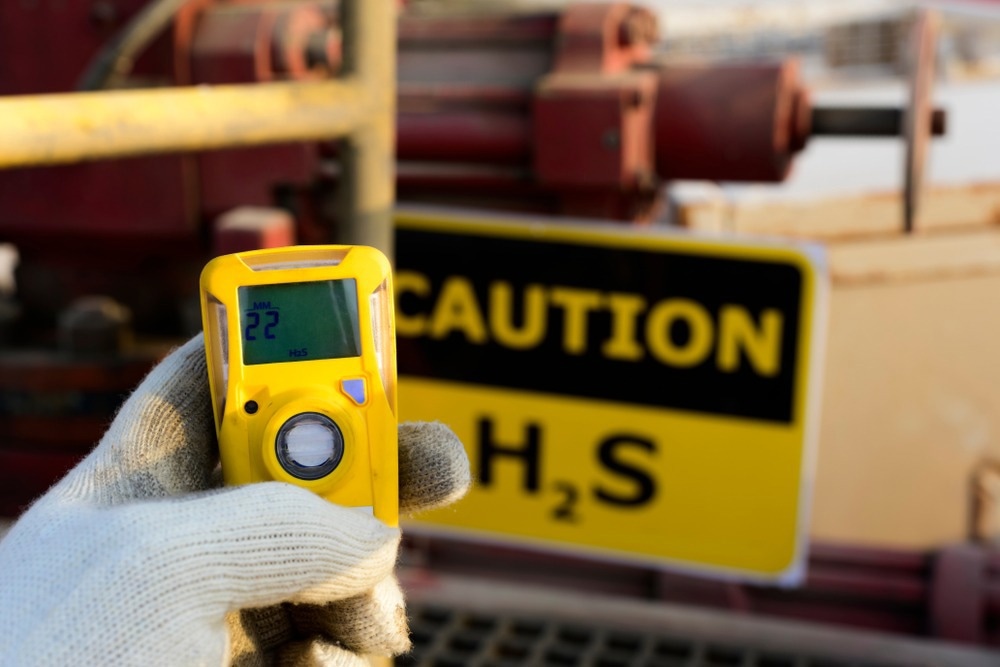A research paper published in the journal Scientific Reports described a promising trinary metal oxide nanocomposite adsorbent for deep desulfurization purposes. A single-step co-precipitation approach was used to create the Mn-Zn-Fe oxide nanocomposite for SO2 and H2S gas removal at ambient temperatures.

Study: Ternary metal oxide nanocomposite for room temperature H2S and SO2 gas removal in wet conditions. Image Credit: P.V.R.M/Shutterstock.com
The Threats Posed by H2S and SO2
Sulfur dioxide (SO2) and hydrogen sulfide (H2S) are air pollutants notorious for causing serious environmental and human health problems. Hydrogen sulfide (H2S) gas is colorless, has the stench of rotting eggs and is very poisonous, corrosive, and combustible.
As H2S is denser than air, it tends to accumulate in low-lying places with poor ventilation. It irritates the throat, nose, and eyes with only five parts per million (PPM) and is lethal at concentrations greater than 1000 ppm. H2S gas can convert into sulfur dioxide (SO2) and its subsequent hydrolysis can cause acid rain.
SO2 is a colorless, poisonous gas having a strong stench. It may cause a variety of respiratory problems, including pulmonary infections and chronic bronchitis. Exposure to SO2 concentrations over 100 ppm may prove fatal.
Thermal power stations and automobile emissions are the primary sources of SO2 in the atmosphere. To minimize air pollution and prevent hazardous situations like acid rain and smog formation, the elimination of SO2 and H2S from their points of origin is imperative.
Mechanism of Chemisorption of H2S and SO2
The chemisorption of H2S and SO2 over an adsorbing surface is a straightforward and cost-effective technique to reduce and mineralize these gases into non-toxic substances like sulfur and sulfates.
Chemisorption is particularly effective for fundamentally challenging and monetarily demanding activities like natural gas purification and flue gas desulfurization.
Oxides of metals are quite promising in this regard because of the existence of weak basic sites along with basic hydroxyl groups. These may engage with H2S and SO2 gases, which are acidic in nature, and function as electron donors.
If water molecules are also present, the surface reactivity of metallic oxides towards H2S and SO2 gases would be enhanced.
The layer of water on the surface of the metallic oxide first undergoes a dissociative reaction, increasing the hydroxyl concentration. The water layer on the surface of the adsorbent then dissolves the H2S and SO2 gas molecules, lowering the activation energy for reactive contact with the surface of the metallic oxide and ultimately favoring the chemical adsorption procedure.
What Did the Researchers Do?
The team used a single-step co-precipitation approach to create an inexpensive Mn-Zn-Fe trinary metallic oxide nanocomposite for SO2 and H2S gas removal at ambient temperatures in wet settings.
For SO2 and H2S, concentrations of 100 and 500 ppm were chosen to accurately depict industrial usability and effectiveness in removing these contaminants.
The metal oxide performed best in wet settings, completely mineralizing to non-toxic byproducts.
Aside from researching the components that influence the adsorption mechanism, the adsorption kinetics were thoroughly investigated using different microscopy and spectroscopy methods.
Important Findings
Manganese dioxide, zinc oxide, and ferrites were used to create the metal oxide nanocomposite. The resulting nanocomposite was evaluated using chemisorption at room temperature in wet and dry settings for SO2 and H2S gas removal.
The dissolution and breakdown of SO2 and H2S gas molecules in the surface water layer allowed the adsorbent to exhibit a higher gas removal capacity in wet settings. The metal oxide performed better in terms of adsorptive capacity at smaller adsorbent loading and flow rates.
H2S gas mineralized into sulfur, sulfide, and sulfite, as verified by a thorough spectroscopic investigation. The iron and manganese redox processes regulated the mineralization process in the presence of molecular oxygen and adsorbed water.
Although zinc ions were not involved in the oxidation reaction, Zn2+ most likely reacted with the sulfites and sulfides. SO2 mineralization was linked with producing sulfates, which was driven by the redox activity of iron and manganese in an oxidizing environment.
The research findings indicated that the trinary metal oxide nanocomposite could perform mineralization of small concentrations of SO2 and H2S and gas removal in dry-wet settings.
The team has ultimately developed a unique adsorption material for the effective mineralization and gas removal of harmful sulfurous substances, which might prove useful in deep desulfurization operations.
Reference
Gupta, N. K., Kim, E. J., Baek, S., Bae, J., & Kim, K. S. (2022). Ternary metal oxide nanocomposite for room temperature H2S and SO2 gas removal in wet conditions. Scientific Reports, 12. Available at: https://www.nature.com/articles/s41598-022-19800-6
Disclaimer: The views expressed here are those of the author expressed in their private capacity and do not necessarily represent the views of AZoM.com Limited T/A AZoNetwork the owner and operator of this website. This disclaimer forms part of the Terms and conditions of use of this website.